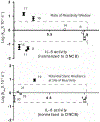Correlating the structure and reactivity of a contact allergen, DNCB, and its analogs to sensitization potential
- PMID: 31128992
- PMCID: PMC8936417
- DOI: 10.1016/j.bmc.2019.05.017
Correlating the structure and reactivity of a contact allergen, DNCB, and its analogs to sensitization potential
Abstract
We report a study that seeks to find a correlation between the overall sensitization potential quantified by the expression of IL-8 by stimulated monocytes and the chemical structure of a model contact allergen, 2,4-dinitrochlorobenzene (DNCB). We show that structure and reactivity of the chemical compounds play an important role in activation of the monocytes and subsequent inflammation in tissue. However, we observed a non-linear correlation between the rate of reaction and biological activity indicating a required balance of stability and reactivity.
Keywords: 1-chloro-2,4-dinitrochlorobenzene (DNCB); Contact hypersensitivity; Interleukin (IL) – 8; Skin sensitization; Structure Activity Relationship (SAR).
Copyright © 2019 Elsevier Ltd. All rights reserved.
Figures







Similar articles
-
Influence of topical exposure to chemical allergens on murine Langerhans cells. Comparison of 2,4-dinitrochlorobenzene with trimellitic anhydride.J Clin Lab Immunol. 1992;37(2):65-81. J Clin Lab Immunol. 1992. PMID: 1340505
-
Impact of the magnitude of sensitization dose on the incidence and intensity of CHS to dinitrochlorobenzene (DNCB): insight from ear swelling and challenged-skin draining lymph node response in rats.J Immunotoxicol. 2013 Oct-Dec;10(4):355-60. doi: 10.3109/1547691X.2012.753960. Epub 2013 Apr 24. J Immunotoxicol. 2013. PMID: 23614785
-
The contact allergen dinitrochlorobenzene (DNCB) and respiratory allergy in the Th2-prone Brown Norway rat.Toxicology. 2008 Apr 18;246(2-3):213-21. doi: 10.1016/j.tox.2008.01.013. Epub 2008 Feb 2. Toxicology. 2008. PMID: 18316151
-
Role of ROS and HMGB1 in contact allergen-induced IL-18 production in human keratinocytes.J Invest Dermatol. 2014 Nov;134(11):2719-2727. doi: 10.1038/jid.2014.203. Epub 2014 Apr 29. J Invest Dermatol. 2014. PMID: 24780928
-
[DNCB contact sensitization: theoretical and clinical aspects (author's transl)].Immun Infekt. 1977 Dec;5(6):227-40. Immun Infekt. 1977. PMID: 338472 Review. German.
Cited by
-
Heat Shock Protein 90's Mechanistic Role in Contact Hypersensitivity.J Immunol. 2022 Jun 15;208(12):2622-2631. doi: 10.4049/jimmunol.2101023. Epub 2022 Jun 8. J Immunol. 2022. PMID: 35675957 Free PMC article.
References
-
- Ashby J, Basketter DA, Paton D & Kimber I Structure activity relationships in skin sensitization using the murine local lymph node assay. Toxicology 103, 177–194 (1995). - PubMed
-
- Kimber I et al. Alternative approaches to the identification and characterization of chemical allergens. Toxicology in vitro : an international journal published in association with BIBRA 15, 307–312 (2001). - PubMed
-
- Divkovic M, Pease CK, Gerberick GF & Basketter DA Hapten-protein binding: From theory to practical application in the in vitro prediction of skin sensitization. Contact Dermatitis 53, 189–200 (2005). - PubMed
-
- McKinney JD The Practice of Structure Activity Relationships (SAR) in Toxicology. Toxicological Sciences 56, 8–17 (2000). - PubMed
Publication types
MeSH terms
Substances
Grants and funding
LinkOut - more resources
Full Text Sources
Miscellaneous

